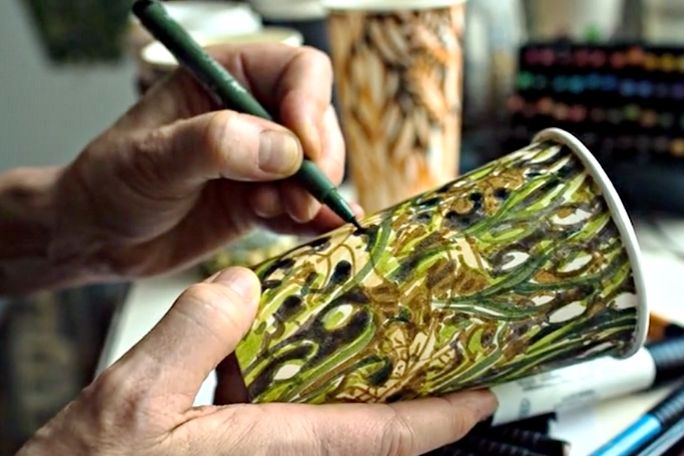Lesson summary
In this lesson of theory and art making, students will explore art and sustainability, focusing on the idea of conscious consumption. They will analyse the work of contemporary artist, Gwyneth Leech and create an artwork on found objects that convey a message of conscious consumption.
Learning intentions:
Students will...
- understand how subject matter influence an artworks underlying message
- Be able to combine 2D and 3D art making techniques
- Be able to select subject matter and art conventions to convey a message about sustainability.
Success criteria:
Students can...
- critically analyse artworks with messages of sustainability
- create artworks on found objects
- convey a message of sustainability through drawing technique and a simple found object sculpture.
Lesson guides and printables
Lesson details
Curriculum mapping
Australian Curriculum content descriptions:
Year 9 & 10 Visual Arts:
- Conceptualise and develop representations of themes, concepts or subject matter to experiment with their developing personal style, reflecting on the styles of artists, including Aboriginal and Torres Strait Islander artists (ACAVAM125).
- Manipulate materials, techniques, technologies and processes to develop and represent their own artistic intentions (ACAVAM126).
- Develop and refine techniques and processes to represent ideas and subject matter (ACAVAM127).
- Plan and design artworks that represent artistic intention (ACAVAM128).
Syllabus outcomes: VAS5.1, VAS5.3, VAS5.4, VAS5.5, VAS5.6
General capabilities: Critical and Creative Thinking.
Cross-curriculum priority: Sustainability.
Relevant parts of Year 9 & 10 achievement standards: By the end of Year 10, students evaluate how representations communicate artistic intentions in artworks they make and view. They evaluate artworks and displays from different cultures, times and places. They analyse connections between visual conventions, practices and viewpoints that represent their own and others’ ideas. They identify influences of other artists on their own artworks. Students manipulate materials, techniques and processes to develop and refine techniques and processes to represent ideas and subject matter in their artworks.
Unit of work: Creative Sustainability – Visual Arts – Year 9 & 10.
Time required: 180 mins.
Resources required
- Student Worksheets – one copy per student
- Device capable of presenting a video to the class
- Student’s own Visual Arts Process Diaries, Pitt Artist pens or Playing & Learning Brush Markers (class set), colour wheels,
- Optional: Colour Theory Factsheet
Skills
This lesson is designed to build students’ competencies in the following skills:
- Communication
- Community Engagement
- Collaboration
- Creativity
- Critical thinking
Additional info
Faber-Castell has long understood the importance of creativity to all people, especially to young people. It is also continuously searching for environmentally friendly processes and high-quality materials to enhance children’s creative experience throughout every development phase. For more information about Faber-Castell, click here.


Welcome back!
Don't have an account yet?
Log in with:
By signing up to Cool.org you consent and agree to Cool's privacy policy to
store, manage and process your personal information. To read more, please see
our privacy policy here(Opens in new tab).
Create your free Cool.org account.
Many of our resources are free, with an option to upgrade to Cool+ for premium content.
Already have an account?
Sign up with:
By signing up to Cool.org you consent and agree to Cool's privacy policy to
store, manage and process your personal information. To read more, please see
our privacy policy here(Opens in new tab).